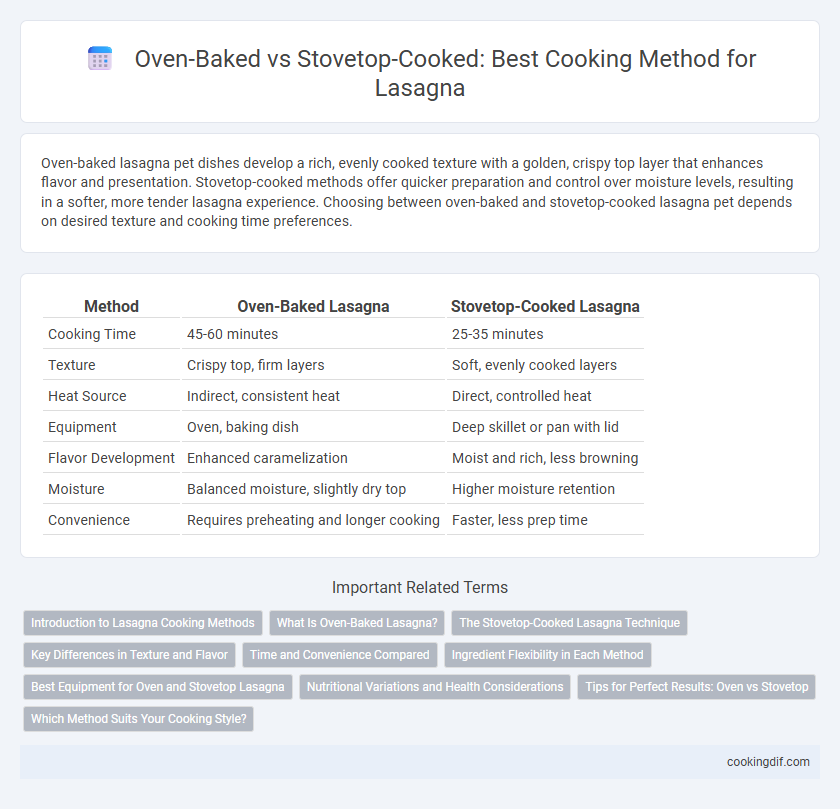Oven-baked lasagna pet dishes develop a rich, evenly cooked texture with a golden, crispy top layer that enhances flavor and presentation. Stovetop-cooked methods offer quicker preparation and control over moisture levels, resulting in a softer, more tender lasagna experience. Choosing between oven-baked and stovetop-cooked lasagna pet depends on desired texture and cooking time preferences.
Table of Comparison
| Method | Oven-Baked Lasagna | Stovetop-Cooked Lasagna |
|---|---|---|
| Cooking Time | 45-60 minutes | 25-35 minutes |
| Texture | Crispy top, firm layers | Soft, evenly cooked layers |
| Heat Source | Indirect, consistent heat | Direct, controlled heat |
| Equipment | Oven, baking dish | Deep skillet or pan with lid |
| Flavor Development | Enhanced caramelization | Moist and rich, less browning |
| Moisture | Balanced moisture, slightly dry top | Higher moisture retention |
| Convenience | Requires preheating and longer cooking | Faster, less prep time |
Introduction to Lasagna Cooking Methods
Oven-baked lasagna offers even heat distribution, allowing layers of pasta, cheese, and sauce to meld together with a crispy, golden top. Stovetop-cooked lasagna provides a quicker alternative, using a covered skillet to steam and cook the ingredients while preserving moisture and texture. Each method affects the flavor profile and texture, making the choice dependent on cooking time and desired outcome.
What Is Oven-Baked Lasagna?
Oven-baked lasagna is a traditional method where layers of pasta, sauce, cheese, and meat or vegetables are assembled in a baking dish and cooked slowly at a consistent temperature, usually around 350degF (175degC). This technique allows the flavors to meld together while creating a golden, bubbly cheese crust and a tender, fully cooked interior. The even heat distribution of the oven ensures thorough cooking and a rich, well-developed texture that stovetop methods typically cannot achieve.
The Stovetop-Cooked Lasagna Technique
The stovetop-cooked lasagna technique offers a quicker alternative to traditional oven-baking by layering pre-cooked noodles, sauce, and cheese in a heavy skillet and simmering on low heat until bubbly. This method retains moisture effectively, resulting in a creamy texture while avoiding the longer cooking times of an oven. Using a lid traps steam and ensures even heat distribution, promoting thorough cooking and melding of flavors without drying out the dish.
Key Differences in Texture and Flavor
Oven-baked lasagna develops a rich, golden crust with layers of melted cheese and tender pasta, creating a harmonious blend of textures from crispy edges to soft, saucy interiors. Stovetop-cooked lasagna tends to have a softer texture overall, with evenly cooked layers but lacks the distinct browned, caramelized top that enhances flavor complexity. The oven method intensifies Maillard reactions, producing deeper savory notes, while stovetop cooking preserves moisture and sharpness in the tomato sauce.
Time and Convenience Compared
Oven-baked lasagna typically requires 45-60 minutes for thorough cooking and allows even heat distribution, resulting in a perfectly browned top layer. Stovetop-cooked lasagna can be prepared in about 20-30 minutes, offering a faster option with easier temperature control but may lack the crispy texture achieved in an oven. For convenience, stovetop cooking suits busy schedules with minimal wait time, while oven baking demands more time but enhances flavor development through slow, consistent heat.
Ingredient Flexibility in Each Method
Oven-baked lasagna allows for layering diverse ingredients such as ricotta, mozzarella, ground meats, and vegetables, enhancing texture and flavor through slow, even cooking. Stovetop-cooked lasagna offers greater flexibility for quick ingredient substitutions and adjustments, perfect for softening pasta sheets in sauce and mixing in delicate greens or seafood without overcooking. Each method supports distinct ingredient integration techniques, with the oven favoring structured layers and the stovetop enabling rapid incorporation of fresh, sensitive components.
Best Equipment for Oven and Stovetop Lasagna
Oven-baked lasagna requires a high-quality, oven-safe dish often made of ceramic, glass, or cast iron to ensure even heat distribution and a perfectly browned top layer. For stovetop lasagna, a deep, heavy-bottomed skillet or saute pan with a tight-fitting lid is essential to maintain moisture and allow gradual cooking without burning. Choosing the best equipment enhances the texture and flavor, making oven baking ideal for a crispy, layered finish, while stovetop cooking offers a quicker, saucier result.
Nutritional Variations and Health Considerations
Oven-baked lasagna typically has a richer nutrient profile due to even melting of cheese and thorough cooking of ingredients, which enhances protein and mineral availability. Stovetop-cooked lasagna often retains more moisture and may have lower fat content, as excess oils can be drained during sauteing, reducing overall calorie density. Health considerations favor stovetop methods for those seeking lower fat intake, while oven-baked lasagna provides a heartier texture and fuller nutrient absorption from the slow, even heat.
Tips for Perfect Results: Oven vs Stovetop
Oven-baked lasagna delivers evenly melted cheese and a golden, crispy top, achieved by preheating the oven to 375degF and baking for 45 minutes covered with foil, then uncovered for the last 10 minutes. Stovetop-cooked lasagna requires a deep, heavy-bottomed skillet with a tight lid, simmered on low heat for 25-30 minutes to allow layers to cook thoroughly and absorb sauce without burning the base. Use low and steady heat for stovetop cooking to prevent sticking and ensure the noodles soften properly, while oven baking benefits from letting the lasagna rest for 15 minutes for easier slicing and better flavor development.
Which Method Suits Your Cooking Style?
Oven-baked lasagna delivers evenly cooked layers with a golden, bubbly top, ideal for cooks who prefer slow, hands-off preparation and rich, melded flavors. Stovetop-cooked lasagna offers a quicker, more flexible option, allowing control over texture and heat, perfect for those seeking a fast, stovetop technique with slightly firmer layers. Choosing between oven and stovetop depends on your available time, desired crust texture, and how much control you want during cooking.
Oven-baked vs Stovetop-cooked for method Infographic

 cookingdif.com
cookingdif.com